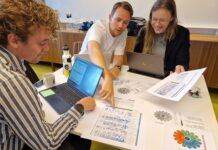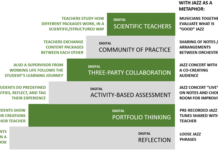[NOTE: This text was later published by Springer, see here]
Entrepreneurship is undeniably an action-oriented, emotional, team-based and interdisciplinary human activity. As the common acronym YCDBSOYA implies, you can’t do business sitting on your armchair. The face value and contribution to education more broadly of an entrepreneurial approach might therefore seem significant and unique. But education has for centuries been inundated with a constant stream of ideas on how to make students more active, collaborative and engaged in their learning. Countless approaches have been proposed that let students take action to do authentic things in groups, aiming to awake their inner desire to learn. It is thus not easy to articulate or substantiate the contribution of entrepreneurial approaches to education.
Therefore, the main question asked here is: What is the unique and novel contribution to general education of an entrepreneurial education approach? Increased clarity on this issue could remedy some of the frequent confusion in interactions between general educators and entrepreneurial educators. Focus will be on learning-by-doing approaches, since traditional lecture-based teaching does not pose a problem in distinguishing a unique contribution. Teaching about entrepreneurship as a topic is easy to distinguish from teaching about other topics.
The blog post is structured as follows. First, the current situation is summarized. Main learning-by-doing approaches in general education are summarized. Then, learning-by-doing approaches in entrepreneurial education are presented and analyzed in relation to their unique and novel contribution to general education. Finally, a brief analysis is conducted based on nine conceptual dimensions of entrepreneurial methods, representing a conclusion and some pointers for future work.
Learning-by-doing approaches in general education
Learning-by-doing can take many forms in general education. Table 1 outlines some common answers to the question “Learning-by-doing-what?” in general education. What to do in order to learn varies depending on which approach is used. Different approaches have different levels of complexity, emotionality and impact. The less complex approaches imply staying in the classroom to solve problems and create artifacts in teams. The more complex approaches imply going out physically into the world outside the school building and participate in more or less organized production of goods and services for customers or other types of beneficiaries. A generic “catch-all” term for all learning-by-doing approaches is experiential learning, implying having an experience that goes beyond lectures, books and exams, and then reflecting upon it.

Learning-by-doing is one of the oldest forms of learning in the history of humanity. Apprenticeship education has been around since late middle ages. A pair of shoes carefully designed and crafted by the shoemaker’s apprentice would inevitably one day be handed over to a presumably satisified customer, constituting the inescapably emotional and deeply motivating “moment of truth” for the young shoemaker apprentice. Most theoretical development of learning-by-doing was, however, done in the 20:th century. Some key contributors were John Dewey, Maria Montessori and David Kolb.
In problem-based learning, students learn through attempting to develop a viable solution to a more or less authentic problem. In project-based learning, such problem-solving activities are organized in a project where students get to work in teams over longer periods of time to take on a more comprehensive problem or issue. Cooperative learning focuses on team-based aspects, implying for example that team members should be dependent on each-other and be individually accountable. Game-based learning is when games, be it analog or digital ones, are designed with educational purposes. In design-based learning, the focus shifts slightly from the process to also be about the outcome of a project. A key focus is to let students learn by producing a more or less innovative artifact, broadly defined as anything created by human art and workmanship.
This necessarily brief and superficial overview will now turn to the more complex and emotional approaches to learning-by-doing where leaving the school building is a definitional and mandatory part of the learning experience[1]. In service-learning, focus is on placing students in real-life situations where they deliver a service experience that meets actual community needs. A key challenge in service-learning is to achieve a good balance between curricular concepts and real-life demands. In cases where real-life activities take over, it is no longer defined as service-learning. A more appropriate term could then be situated learning, defined as the learning that occurs when newcomers work together with old-timers in a community of practice. A related term here is work-integrated learning, where students are integrated into worklife for the purpose of learning. Common forms of work-integrated learning are internships and apprenticeships.
Learning-by-doing approaches in entrepreneurial education
Also in entrepreneurial education, learning-by-doing can take many different forms. Table 1 outlines some common answers to the question “Learning-by-doing-what?” in entrepreneurial education. Ideally, the different forms constitute a progressive learning journey in three stages. Opportunity creation is followed by value creation and then finally venture creation. In an early stage characterized by relatively low complexity, ideas and opportunities are explored or created, primarily in a classroom. The resulting ideas and prototypes are then acted upon in attempts to make a valuable and tangible real-life contribution to people outside the classroom or the school building. The third and final stage is about organizing the endeavor into a new social or business venture. All three stages can be supported by entrepreneurial methods.
Early examples of learning-by-doing in entrepreneurial education were based on approaches taken from general education. Students learned through on-site internships for practising entrepreneurs, through trying to solve more or less authentic problems that entrepreneurs face, and through team-based projects. The novelty about this was that existing learning-by-doing approaches in general education were applied to entrepreneurship as a new field of study. Therefore, they did not contribute with novelty back to general education.
1970s: Business opportunity-based learning
In what could be the first example of a learning-by-doing approach more unique to entrepreneurial education, students were from the 1970s asked to come up with an idea representing a business opportunity and write a business plan around it (Ronstadt, 1990). Over time, this approach developed its sophistication, involving an increasing array of techniques for creative ideation, prototype creation, business idea pitching and prototype testing to reveal the robustness of one’s assumptions. A unique and novel contribution to education of this approach could be its focus on opportunities rather than on problems. It has been claimed that people get more motivated by working with opportunities than by working with problems. A focus on being creative around opportunities to make money could then be viewed as a contribution to general education, being a different perspective than the usual problem-solving focus in established learning-by-doing approaches. A challenge here is that most non-business teachers have difficulties in seeing the relevancy of teaching students to make money, at least in relation to their own curricular subject.
1970s: Venture creation-based learning
Around the same time[1], another learning-by-doing approach unique to entrepreneurial education emerged. Secondary school students learned about the world of business through starting and running a real-life mini-venture for around eight months. This rather complex activity necessitated concept providers such as Junior Achievement in the US and Young Enterprise in the UK. These organizations grew over the years, and have today reached worldwide diffusion with a presence in 120 countries, reaching around 10 million students yearly. Letting students learn through starting a real-life mini-venture was also picked up by colleges and universities. In some rare cases, students are even required to start a full-scale in-curricular venture in what has been termed “Venture Creation Programs”. If the venture becomes successful, it gets incorporated by the newly graduated students who then become founders and owners. Another kind of venture creation-based learning is when it is combined with game-based learning into analog or digital venture simulations.
A unique and novel contribution to education of the venture creation approach could be the real-life activity of starting and running a real venture for some time, with real paying customers. Prior to the 1970s, such an experience had not previously been integrated into curricular activities. Just like for business opportunity-based learning, a challenge has been that most non-business teachers do not see the relevancy of letting students run a venture, at least not in relation to their own curricular subject.
Learning through business opportunities and through venture creation have met significant resistance in attempts to apply them more broadly in education. Most teachers reject the two approaches, since they perceive them as irrelevant in relation to their own non-business curriculum. While both novel and unique in their character, the two approaches have thus not succeeded much in contributing to general non-business related education. They have instead remained marginal, making up less than 1% of the world’s education related activities.
1990s: Opportunity-based learning
The difficulties in applying a business-centric approach more broadly in education led in the 1990s to a new approach being proposed by professor Allan Gibb in the United Kingdom. The new approach was termed “enterprise” education, distinguishing it from the narrower business venture creation approach, termed “entrepreneurship” education. Money-making, business management and organization creation connotations were de-emphasized or removed altogether. Enterprise education was positioned largely as a pedagogical approach. It was presented as a reaction against passive, formal and detached teaching of abstract content. Instead, emphasis was put on active and experiential learning from a creative and authentic process of participation. The aim was to make students learn those competencies needed to be able to generate and realize ideas and opportunities. Being enterprising was positioned as an opportunity-focused posture, requiring ‘entrepreneurial’ competencies such as initiative, creativity, perseverance and tolerance for uncertainty.
While enterprise education was a liberating move for many teachers not keen on integrating business venturing into their teaching, other teachers were confused. Was it a mere replication of progressive education principles? Progressive education is a centuries-long tradition in general education, leaning on giants such as Comenius, Rousseau, Dewey, Montessori, Steiner, Freinet and many others. Its main tenets are very similar to enterprise education. Due to this similarity, some scholars have questioned whether enterprise education is a novel and unique contribution to general education. They instead claim that it is a typical case of “old wine in new bottles”, i.e. a mere relabeling of a well-known concept, only contributing to conceptual confusion. Some have even posited enterprise education to be a dangerously diluted version of entrepreneurship, jeopardizing both its distinctiveness, legitimacy and potential impact in education (see for example Neck and Corbett, 2018).
Still, there is at least one possible unique and novel contribution that enterprise education could claim. It has a clear focus on opportunities rather than on problems. Not only business opportunities but any kind of individually perceived opportunity in life. This aligns with a common definition of entrepreneurship viewed as being about an individual meeting an opportunity. If one could evidence the value of learning through exploring opportunities also in non-business subjects, enterprise education could indeed become a unique and novel contribution to education more broadly. But so far, evidence is scant apart from qualitative single case studies conducted by enthusiastic teachers at universities, most often at business schools. Many teachers have also perceived enterprise education as fuzzy and difficult to integrate into their existing teaching. Enterprise education is so far therefore difficult to scale broadly in general education.
2000s: Entrepreneurial method-based learning
A recent addition to learning-by-doing in entrepreneurial education entails letting students apply entrepreneurial methods. It reached significant traction in late 2000s. Some common entrepreneurial methods include “effectuation logic” as prescribed by scholar Saras Sarasvathy, “lean startup methodology” as prescribed by entrepreneur Eric Ries, and “design thinking” as prescribed by practitioners in the product design community. Students can apply effectual principles such as starting a creative process with what they have, who they are and whom they know. Students can apply lean startup principles such as building a prototype and testing it on real-world stakeholders to see if their assumptions about what is deemed valuable hold true. Students can also use empathy and observation principles in design thinking to learn about what new solutions are needed in society.
These distinctly entrepreneurial methods arguably represent a both unique and novel contribution if diffused more broadly into general education. Previous learning-by-doing approaches in general education have not given similar prescriptions on how to go about solving problems, running team-based projects or facilitating experiential learning. The reason these entrepreneurial methods can be so detailed is because they are based on careful studies of and distilled experiences from real-world experts in entrepreneurship. But there is a limitation also here. Entrepreneurial methods are all based on primarily business centric practices, so the problem of business venturing not appealing to most non-business teachers is again coming back.
Up until the 2010s, teachers in non-business subjects interested in entrepreneurial education have thus been faced with a difficult choice between the distinct but commercially oriented business-based practices and the perceived broader relevancy of a fuzzy and unproven enterprising approach.
2010s: Value creation-based learning
In the 2010s, a new trend in entrepreneurial education has been to remove the focus on business creation but to keep and reinforce a focus on students creating value for real-world stakeholders. Creating value for others has been a core tenet of entrepreneurship since the 18th century, when pioneering economist Richard Cantillon defined entrepreneurs as non-fixed income earners. Entrepreneurs take a risk by being dependent on the uncertain income paid in exchange for the customer value they create. The corresponding learning-by-doing approach in education prescribes students to learn from an uncertain process of trying to create real-life tangible value for external stakeholders. The value created can be social, cultural, ecological or enjoyment based, thus taking a broad view on what is valuable. The reward for students is in most cases not income, but a highly engaging and relevant learning experience. Empirically speaking, strong development of entrepreneurial competencies has been easier to prove from letting students learn through value creation than from organizing enterprise education activities.
An educational emphasis on students creating value for others has made it easier for entrepreneurial education to contribute more broadly to non-business subjects and on educational levels outside colleges and universities. Teachers get access to the strong motivational effects of entrepreneurial activities without having to deal with a problematic business emphasis at odds with curricular content or with the fuzzy enterprise concept difficult to act upon.
Letting students learn through creating value for others is not new to general education. It has very old traditions, such as apprenticeship education, internships and other work-integrated and socially situated forms of learning. Also service-learning involves students creating value for others. The novel and unique contribution here can rather be articulated as its broad applicability in general education, and in its reliance on entrepreneurship as a practice grounded in expertise, traditions and prescriptive methods. While work-integrated learning is a quite marginal approach primarily used in secondary and tertiary vocational education, learning through creating value for others has been possible to integrate into all subjects and on all levels of education. Another contribution to existing value creation practices in education is an emphasis on novelty. Established forms of value creation in education entail mainly routine-based value creation. Students create value to well-known customers on established markets. When more novel value is created by students, motivation and learning can become even deeper and entrepreneurial methods and practices can support the learning process.
The unique and novel contributions summarized: Opportunities, methods and value creation
Summarizing the unique and novel contribution of entrepreneurial education more broadly, three aspects stand out; opportunities, methods and value creation. While unique and novel one by one, they could also be combined. Teachers can let students learn through applying entrepreneurial methods, resulting in opportunities to apply curricular content, hopefully leading to more or less novel value creation for external stakeholders. This represents a novel, unique and broadly applicable contribution that entrepreneurship can make to general education.
Stripped of its business connotations, entrepreneurship as an opportunity-oriented value-creating practice and a domain of expertise and methods can thus empower general education. It provides a simple to integrate yet powerful purpose for those students who ask themselves and their teacher “Why are we doing this?”. Curriculum content applied in value-creating practices becomes more engaging, motivating and relevant. This deepends and expands student learning. It is also a new answer for many teachers who might be asking themselves the question “Learning-by-doing-what?”.
A group of teachers that could find this a slightly less novel approach could be a small group of vocational educators working with apprenticeships and work-based learning. But also this group of teachers could benefit from a stronger opportunity focus, a stronger novelty focus, and entrepreneurial methods relieved of their business semantics.
A final comparison is conducted in Table 2, where nine entrepreneurial dimensions common to many entrepreneurial methods are matched with the learning-by-doing approaches in general education outlined in Table 1 (dimensions taken from Mansoori and Lackéus, 2019). The matching is tentative, and should be seen here as a possible foundation for future work and food for thought. Some entrepreneurial dimensions are much more common in general education than others. Rare dimensions in Table 2 represent an opportunity to expand future work on what is unique and novel with entrepreneurial education. Also, if entrepreneurship is viewed as a practice simultaneously combining all nine dimensions, a contribution to general education could be when students get to experience all of them simultaneously in their education. Perhaps entrepreneurial education can even be defined as when students as formal part of their education get the opportunity to “manage uncertainty by expanding their knowledge and resource base through continuous learning from feedback, in an iterative and interactive manner involving close collaborators, acting to create new kinds of value for oneself and for others”? (cf. Mansoori and Lackéus, 2019).

[1] One could certainly find examples of problem-based, project-based and design-based learning where students get to leave the school building, since reality is always much more complex than any idealized concept. Focus here is, however, to give a succinct and simplified overview of learning-by-doing approaches.
[2] While Junior Achievement started already in 1919, its first 50 years were focused on after-school programs.
References
MANSOORI, Y. & LACKÉUS, M. 2019. Comparing effectuation to discovery-driven planning, prescriptive entrepreneurship, business planning, lean startup, and design thinking. Small Business Economics, In press.
NECK, H. M. & CORBETT, A. C. 2018. The scholarship of teaching and learning entrepreneurship. Entrepreneurship Education and Pedagogy, 1, 8-41.
RONSTADT, R. 1990. The educated entrepreneurs: A new era of entrepreneurial education is beginning. In: KENT, C. A. (ed.) Entrepreneurship Education: Current Developments, Future Directions. Greenwood Publishing Group.









Hi Martin, Allan Gibb’s work was not intended for schools but the Higher Education sector, so the 90’s column doesn’t quite fit as it stands. No one in schools level education used this at the time.
FYI this is what evolved, but this was not until the Davies Review of Enterprise and the Economy in Education in 2002 and this was only for English Schools (to which you seem to be referring). They remain the definitions that are used in English School inspections (Ofsted).
FYI Wales also developed a strategy in the 2000s, and this was based on the ACRO model of Attitude, Creativity, Relationship and Organisation, so the two countries had quite different approaches.
I’ll cut and paste the English Davies Review definitions below – hope this clarity helps?
• Enterprise capability is the ability to handle uncertainty and respond positively to change, to create and implement new ideas and new ways of doing things, and to make reasonable risk/reward assessments and act on them in one’s own personal and working life. It can also be described as innovation, creativity, risk management, having a ‘can- do’ approach and the drive to make ideas happen.
• Financial capability is the ability to manage one’s own finances and to become questioning and informed consumers of financial services.
• Economic and business understanding is the ability to understand the
business context and make informed choices between alternative uses of scarce resources.
(Davies, 2002: 17–18)
Value Creation is fine.. But that is not enough. VALUE itself and measurement, and validation of it met with lot of problems . Some of the reasons are…… many a times the VALUE that is created, is NOT Concrete, NOT Monetary, NOT VALID, NOT AUDITABLE, Not AUTENTIC.. ! Students who are Poor and Marginalised badly need VALUE in REAL and that too in REAL TIME ! Value Creation to Value conversion into concrete and cash form is the ULTIMATE way of Enterprising the academic learning . I wish focus is not missed of VALUE COLLECTION and CASHIFICATION !